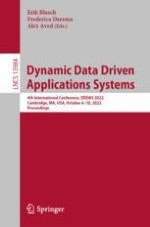2024 | Buch
Dynamic Data Driven Applications Systems
4th International Conference, DDDAS 2022, Cambridge, MA, USA, October 6–10, 2022, Proceedings
herausgegeben von: Erik Blasch, Frederica Darema, Alex Aved
Verlag: Springer Nature Switzerland
Buchreihe : Lecture Notes in Computer Science
